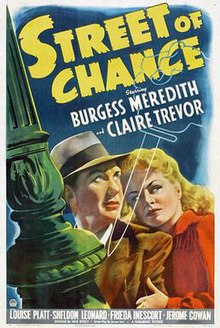
Crossfire is a 1947 American film noir drama film starring Robert Young, Robert Mitchum and Robert Ryan which deals with the theme of antisemitism, as did that year's Academy Award for Best Picture winner, Gentleman's Agreement. The film was directed by Edward Dmytryk and the screenplay was written by John Paxton, based on the 1945 novel The Brick Foxhole by screenwriter and director Richard Brooks. The film's supporting cast features Gloria Grahame and Sam Levene. The picture received five Oscar nominations, including Ryan for Best Supporting Actor and Gloria Grahame for Best Supporting Actress. It was the first B movie to receive a Best Picture nomination.
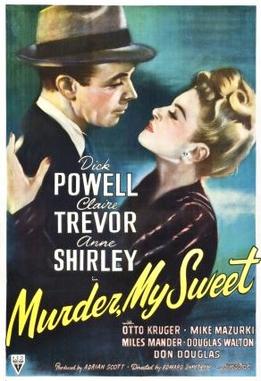
Murder, My Sweet is a 1944 American film noir, directed by Edward Dmytryk and starring Dick Powell, Claire Trevor and Anne Shirley. The film is based on Raymond Chandler's 1940 novel Farewell, My Lovely. It was the first film to feature Chandler's primary character, the hard-boiled private detective Philip Marlowe.

On Dangerous Ground is a 1951 film noir directed by Nicholas Ray, starring Robert Ryan and Ida Lupino, and produced by John Houseman. The screenplay was written by A. I. Bezzerides based on the 1945 novel Mad with Much Heart by Gerald Butler.

Criss Cross is a 1949 American film noir crime tragedy film starring Burt Lancaster, Yvonne De Carlo and Dan Duryea, directed by Robert Siodmak and written by Daniel Fuchs based on Don Tracy's 1934 novel of the same name. This black-and-white film was shot partly on location in the Bunker Hill section of Los Angeles. Miklós Rózsa scored the film's soundtrack.

The Blue Gardenia is a 1953 American film noir starring Anne Baxter, Richard Conte, and Ann Sothern. Directed by Fritz Lang from a screenplay by Charles Hoffman, it is based on the novella The Gardenia by Vera Caspary.

The Naked City is a 1948 American crime procedural produced by Mark Hellinger, directed by Jules Dassin, written by Albert Maltz and Malvin Wald. Starring Barry Fitzgerald, with Howard Duff, Dorothy Hart and Don Taylor in support, the film depicts the police investigation that follows the murder of a young model. It was shot almost entirely on location in New York City.
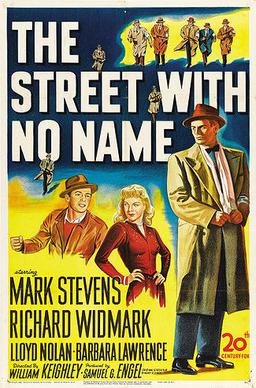
The Street with No Name is a 1948 American film noir directed by William Keighley. A follow-up to The House on 92nd Street (1945), it tells the story of an undercover FBI agent, Gene Cordell, who infiltrates a deadly crime gang. Cordell's superior, FBI Inspector George A. Briggs, also appears in The House on 92nd Street. The film, shot in a semidocumentary style, takes place in the Skid Row section of fictional "Center City".

Moonrise is a 1948 American film noir crime film directed by Frank Borzage starring Dane Clark, Gail Russell and Ethel Barrymore. It is based on the 1946 novel of the same name by Theodore Strauss. The plot concerns the son of a man who was hanged for murder, leading to his own bullying by others and subsequent trials when he commits a crime in self-defense.

Red Light is a 1949 American film noir crime film starring George Raft and Virginia Mayo, and directed and produced by Roy Del Ruth. Based on the story "This Guy Gideon" by Don "Red" Barry, it features strong religious overtones.

The Kill-Off is a 1989 American crime drama film written and directed by Maggie Greenwald, based on a 1957 novel of the same name by Jim Thompson. It was an independent film, produced by Lydia Dean Pilcher and shot by Declan Quinn in his film debut.

Jigsaw is a 1949 American film noir crime drama directed by Fletcher Markle starring Franchot Tone, Jean Wallace and Marc Lawrence. The feature was produced by the Danziger Brothers, Edward J. Danziger and Harry Lee Danziger from a screenplay by Vincent McConnor and Fletcher Markle, which was based on a story by John Roeburt.

On Our Merry Way is a 1948 American comedy film produced by Benedict Bogeaus and Burgess Meredith and released by United Artists. At the time of its release, King Vidor and Leslie Fenton were credited with its direction, although the DVD lists John Huston and George Stevens, who assisted with one of the segments, as well. The screenplay by Laurence Stallings and Lou Breslow, based on an original story by Arch Oboler, is similar in style to that of Tales of Manhattan (1942), another anthology film made up of several vignettes linked by a single theme. The picture stars Paulette Goddard, Burgess Meredith, James Stewart, Henry Fonda, Harry James, Dorothy Lamour, Victor Moore and Fred MacMurray. It marks the first joint movie appearance of Stewart and Fonda, who play a pair of musicians in their section of the film.

Cop Hater is a 1958 American crime film noir police procedural film based on the 1956 novel Cop Hater written by Ed McBain, the first in a series of books about the 87th Precinct in New York City. The film was produced and directed by William Berke, written by Henry Kane and stars Robert Loggia and Gerald O'Loughlin.
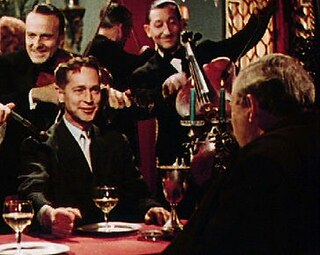
The Man on the Eiffel Tower is a 1950 American Ansco Color film noir mystery film starring Charles Laughton, Franchot Tone, Burgess Meredith, and Robert Hutton. Ultimately directed by Meredith, it is based on the 1931 novel La Tête d'un homme by Belgian writer Georges Simenon featuring his detective Jules Maigret. The film was co-produced by Tone and Irving Allen as A&T Film Productions and released by RKO Radio Pictures. Much of the outdoor action occurs in familiar Paris locales, including the Eiffel Tower, the Seine, and Pigalle.
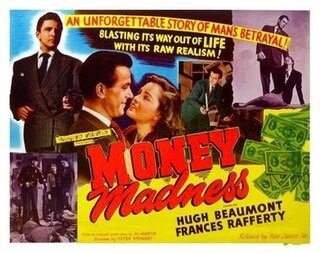
Money Madness is a 1948 film noir mystery film directed by Sam Newfield starring Hugh Beaumont and Frances Rafferty.

Tomorrow Is Another Day is a 1951 crime drama film noir directed by Felix E. Feist and starring Ruth Roman and Steve Cochran. An ex-convict who thinks he killed a man goes into hiding with a woman whose boyfriend is the man he supposedly killed.

Shield for Murder is a 1954 American film noir crime film co-directed by and starring Edmond O'Brien as a police detective who has become malevolent. It was based on the novel of the same name by William P. McGivern.
No Questions Asked is a 1951 American crime film noir directed by Harold F. Kress and starring Barry Sullivan, Arlene Dahl, George Murphy and Jean Hagen.
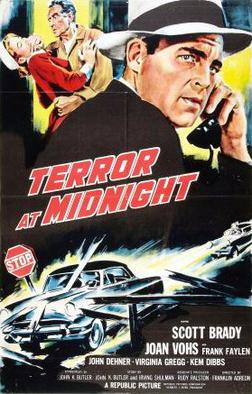
Terror at Midnight is a 1956 American film noir crime film directed by Franklin Adreon and starring Scott Brady, Joan Vohs and Frank Faylen.

Jack Hively was an American film editor and film and television director whose career lasted from the 1930s through the 1980s. His father and his brother were also film editors. He began as a film editor, before moving on to direct features. His career was interrupted by his enlistment in the U.S. Army following the Japanese bombing of Pearl Harbor in December 1941. After the war he returned to directing films, before moving on to directing on television.
